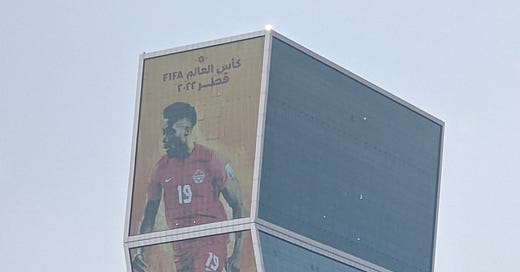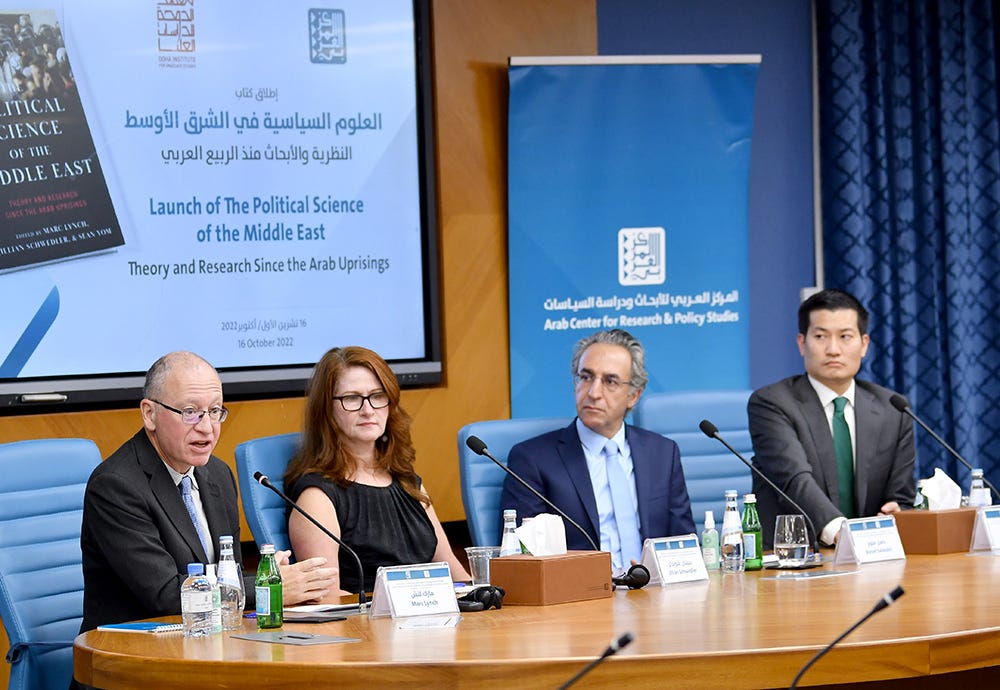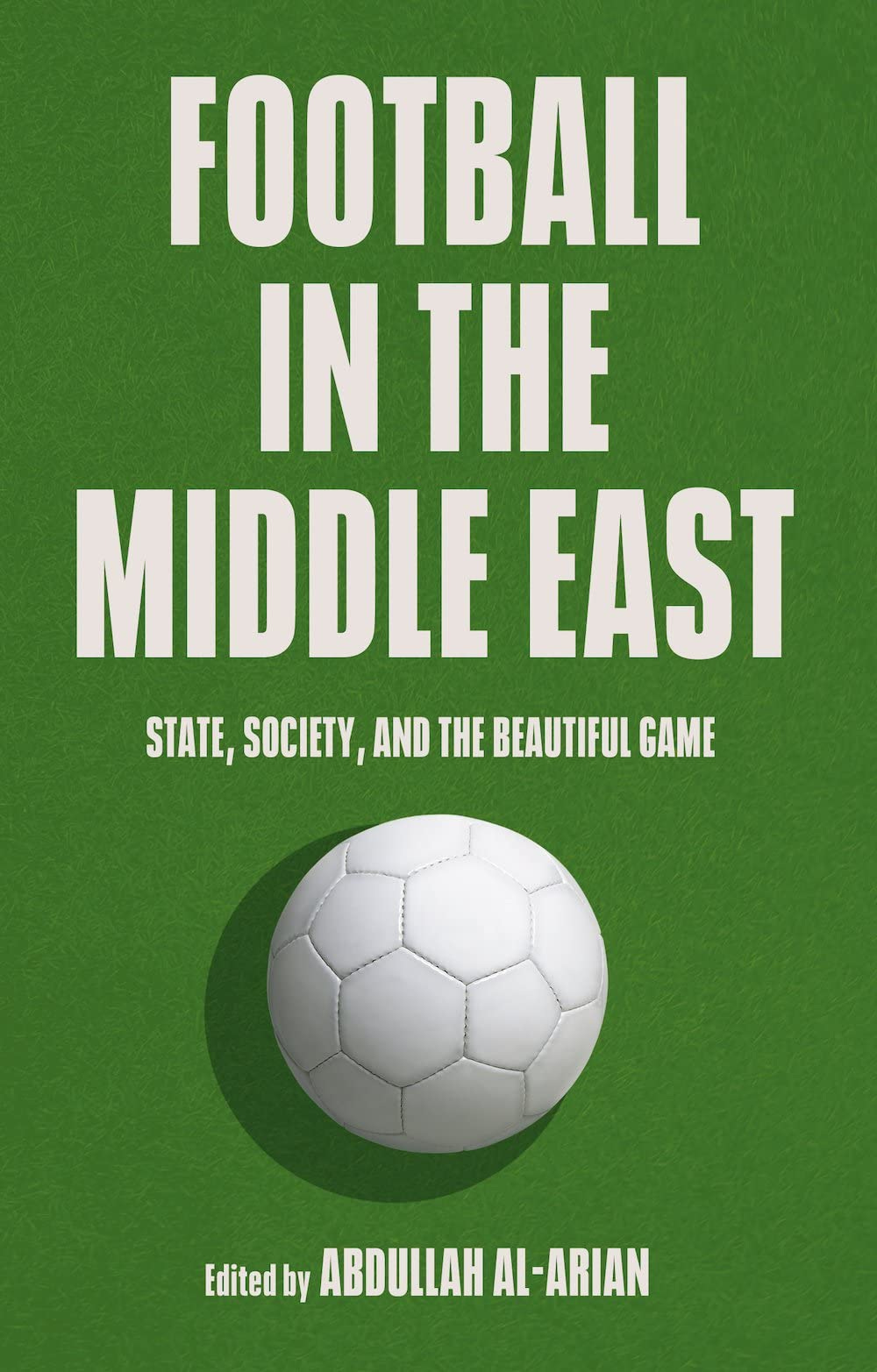Abdullah al-Arian, editor, Football in the Middle East: State, Society, and the Beautiful Game (Oxford University Press)
I spent a few days in Doha last week as part of a great collaboration with the Doha Institute for Graduate Studies and the Arab Center for Research and Policy Studies. The centerpiece was a book launch event for The Political Science of the Middle East: Theory and Research Since the Arab Uprisings. Bassel Salloukh hosted Jillian Schwedler, Sean Yom and me in a really great discussion about the book, with wideranging participation by Doha Institute and Arab Center faculty and staff, as well as a lot of others from around the city. It meant a lot to be able to present and discuss our book about Middle East political science scholarship at a great academic institution in the Middle East to a first-rate group of Arab political scientists.
There was a lot more going on during our visit. Steven Heydemann and Lisa Anderson gave keynote lectures as well. And in between the public events, the five of us from the U.S. spent half a day exchanging ideas and feedback with almost a dozen of the Arab Center and Doha Institute scholars about our respective books in progress on the Arab state. I came away once again impressed with the quality and rigor of the academic programs that Azmi Bishara and his leadership team have developed in such a short time. In a future post, I’ll be talking about some of the Arabic-language journals that they are publishing, and other related scholarship.
But for now, I wanted to talk about something else: the World Cup. As I’m sure everyone reading this knows, Qatar is set to host the 2022 FIFA World Cup in just a couple of weeks. I have no idea how it’s going to go, and neither does anyone else (the unforgettable term “goat rodeo” came up in one conversation). But I have to admit to being stunned by the amount of infrastructural development in Doha since the last time I visited pre-COVID. Roads, public spaces, hotels, indoor and outdoor malls, a metro train, the new stadiums… it’s just dizzying. I’ll be curious to see how it all holds up to the coming deluge.
To get myself in the right mindset to appreciate Doha on the eve of the World Cup, I tucked Abdullah al-Arian’s fabulously interesting brand new edited volume Football in the Middle East into my backpack. Good call. Like most edited volumes, this one jumps around from topic to topic, and the contributions range widely in terms of their focus, methodology, disciplinary approach, and style. But this is one of those edited volumes where nearly everything is interesting.
To be completely transparent, I’m not a huge fan of soccer / football — I mean, I like it, I basically know who Mo Salah is, and I’ll usually watch the later rounds of the World Cup. But I’m not what you’d call a “fan.” I know this because of Simon Chadwick’s elegant discussion of the concept of fandom in his provocative chapter on GCC football fans. By his typology, I’m afraid that I’m a “temporary fan” with no strong allegiances to any national or club team (in sharp contrast to my passionate attachment to Wisconsin teams in other sports like the Green Bay Packers, Milwaukee Brewers, and Milwaukee Bucks). One thing I found intriguing in Chadwick’s discussion of Gulf football fandom is the balancing act between fandom of local and international teams. The loyalties to European premiere clubs shows the deeply transnational and international nature of the game - from Gulf ownership of those teams (dissected by al-Arian in his own chapter) to chosen fixations on one or another of the top squads.
The most relevant chapter to my experience of Qatar was Zahra Babar’s insightful exploration of the advocacy campaign against Qatari treatment of migrant labor which launched and gained steam immediately following the 2010 announcement of its selection. Babar does a great job of putting the status of migrant labor in Qatar into two key contexts: other Gulf countries, and other World Cup hosting countries. Many World Cups, she notes, require massive infrastructural development, and often rely on migrant labor working at vast scale under great time pressure. Brazil, for instance, was also the target of an advocacy campaign during its preparations. But, she suggests, advocacy on Qatar tended to exoticize it and the rest of the Gulf in ways which concealed rather than illuminated the deep transnational flows which characterize global labor migration. Qatar did take significant steps towards reforming the labor migration system in the decade after 2010, cracking down on contract switching and wage theft while opening up the possibility for workers to shift employers in ways not previously possible under the kafala system. She argues that the most significant steps came after the 2017 blockade of Qatar led by Saudi Arabia and the UAE. Under the harsh glare of their demonization campaigns, Qatar had a strong incentive to improve its global image, and the advocacy campaign made labor reform a key way to do so. Less well appreciated from the outside is that the public’s rallying around the throne in the face of the blockade allowed the Emir to in a sense bypass long-running hostility to labor reform by Qatari businessmen and citizens. Babar’s account raises important questions about such advocacy campaigns, about the ability of a state like Qatar to meaningfully change the labor migration system, and of the sustainability of those changes which were made.
Another standout chapter for me was Thomas Ross Griffin’s chapter on Qatari national identity and its national football team. Griffin uses the 2019 Asian Cup winning Qatari national team - a remarkable accomplishment under the circumstances of the blockade - to look into the gradations of citizenship and nationality in the context of a state where some 80% of the residents do not have Qatari citizenship. The team included players of three gradations: full Qatari citizens, long-term residents born in Qatar, and players naturalized to represent Qatar. These players represent the demographic diversity and long history of transnational connections which characterizes the Gulf states: one born in Qatar by Sudanese parents; one born in Qatar from a Yemeni mother and a Tanzanian football star father. Perhaps the most fascinating of the vignettes looks at Basam al-Rawi, a Baghdad-born player who scored the winning goal in a critical Asian Cup match against his home country of Iraq.
The volume ranges well beyond Qatar, of course. I learned a tremendous amount from Ibrahim Elhoudaiby’s historical reconstruction of the evolution of football in Egypt. I was particularly taken with his account of the relationship with the cultivation of the forms of modernity among the effendi class, the transformation from street games into regulated, formal, refereed games with distinct beginnings and endings, recorded scores, and league rankings. Elhoudaiby traces the football leagues through the ebbs and flows of nationalism and anti-colonialism.
Maher Mezahi, by contrast, focuses on the role of football fans in the 2019 Hirak movement in Algeria. Like Elhoudaiby, he traces the evolution of Algerian football clubs and leagues through colonialism and national independence, with particular attention to the tension between the French leagues, Arab and Muslim clubs, and (later) Amizagh activism (as in the JS Kabyle club’s fans during the1980 Berber Spring). The real heart of his chapter, though, is a loving reconstruction of popular songs and chants that he traces from the football games he attends to the Hirak demonstrations he covers. His dissection of key lyrics really shines light on Algerian popular demands and narratives, and also makes me want to find some good playlists.
The other chapter which really caught my eye was Niki Akhavan’s exploration of gender segregation in Iran’s football stadiums. Like Nazanin Shahrokni’s brilliant book (which I reviewed here), Akhavan’s chapter traces the imposition of gender segregation by the Islamic Republic following the 1979 revolution and its emergence as a political issue in the early 2000s. Women’s demands to attend football matches were part and parcel of the broader emergence of a huge cohort of educated, professional women into a public sphere designed for gender separation. She shows how Iranian women leveraged the 2019 tragedy of Sahar Khodayari’s self-immolation after her failed attempt to disguise herself as a man to sneak into a game, and the international spotlight brought by FIFA to put pressure for change. This is all of obvious relevance to the revolutionary mobilization by Iranian women over the last month.
The rest of the book’s chapters are all full of fascinating information, analysis, and stories. Yagmur Nughrat looks at women’s football in Turkey; Danyel Reiche examines Palestinians trying to play football as refugees in Lebanon; Ramon Sapaaij takes up the broader question of refugees; Aubrey Bloomfield looks to the importance of the sports boycott in undermining Apartheid South Africa to argue for a football BDS movement towards Israel; Craig LaMay looks at regional football broadcasting. It all only whetted my appetite for more research on these topics. Now I’m even more excited for the POMEPS workshop I’m organizing with Georgetown Qatar’s Zahra Babar on the theme of sports and politics a month after the World Cup. There’s so much to explore!






